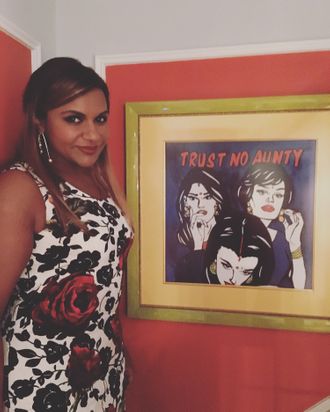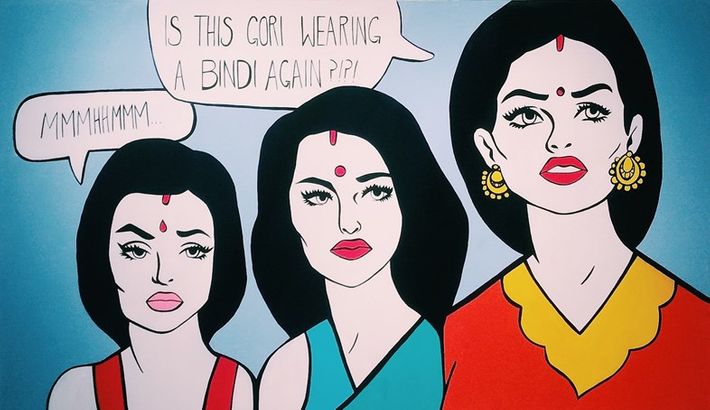
On The Mindy Project, Mindy Kaling plays a character who, like her, is provocative about race in ways that tend to bother critics. Dr. Mindy Lahiri self-identifies as a “coconut” (brown on the outside, white on the inside). When she’s not disowning her otherness, she likes what it does for her, feeding her huge hunger for specialness (as another character once put it, she “hates not being the only Asian in the room”).
Kaling’s stance in real life feels even more complicated. While she’s publicly argued against having to talk endlessly about race or represent an entire people, her Instagram and Twitter accounts often double as platforms for the work of fellow desis. Over the years, she’s repped earnest and ironic brown causes alike on her accounts, from an activist Indian comic book to a desi bridal-clothing company to Aziz Ansari.
That repping hasn’t bled into the show until this season. Dr. Lahiri’s apartment — until now a pretty standard expression of Kaling’s blinged-out Pinterest-meets-princess vibe — has some new pieces by Maria Qamar, the Toronto-based artist behind the popular Instagram account @hatecopy. One of Qamar’s prints — Lichtensteinian takes on South Asian themes of honor, disgrace, secrecy, melodrama, and pride — now hangs on a wall of Lahiri’s apartment, requested by Kaling herself. A work by Qamar’s friend and fellow South Asian–Canadian artist Babneet Lakhesar, a.k.a. Babbu the Painter, is also featured on the show, along with a collaboration by the two artists. And lately on Instagram, Kaling has been rocking one of Qamar’s works — a T-shirt with a mesmerizing repeat design of a bindi-ed face.
Qamar, who moved with her family from Pakistan to Canada during her childhood, is part of a wave of young brown artists who’ve gained cross-cultural attention, scoring shout-outs in Lena Dunham’s Lenny newsletter and national South Asian publications. For people like Qamar, Kaling is kind of like a queen: distant and powerful. Few brown women hold the mainstream appeal she has. Reaching back and patting the backs of South Asians behind her may never have been Kaling’s stated goal, but with each small gesture, Qamar quips, she’s becoming “the Bill Murray of the brown internet.”
Vulture chatted with Qamar by phone about how she got on The Mindy Project, and why so many South Asian women look up to Kaling.
Were you a fan of The Mindy Project before you got on the show?
Mindy’s like my idol. Mindy’s the goal. I followed her from The Office to The Mindy Project. As soon as Is Everyone Hanging Out Without Me? [Kaling’s first book] came out, I was like, I gotta get this. My brother and I would bond over the show because he’s a doctor. He’d call me up, like, “Did you see this episode?”
And now your work is in them. How did that happen?
She just started following me one day. I was hanging out in my apartment. It was after our Shame Shame exhibit in Toronto. I got a WhatsApp message from Babbu that was like, “Mindy Kaling. We gotta go to L.A. and hang out with her.” I just thought it was a joke, so I played along, like, “Yeah, let’s go hang with all the stars.” I hadn’t checked my Instagram that day. When I opened it, and it was like, Mindy Kaling is now following you, I was like, “Ohh, what?” I was screaming. Running around the house. I’ve never been starstruck before, but it was like, this person who you looked up to that whole time likes what you’re doing. It’s not only feeling starstruck, it’s like a huge pat on the back, like, You’re doing good. I was so happy. [For a while she was] casually following us, commented on a few photos. I was like, cool cool, I’m doing well, left it at that — bragging rights, put that on a business card.
And then …
We were in London in August, running around, putting a show together. The opening night brought in 500 people alone. It was crazy. We were exhausted, tired, and wrapping it up, getting ready to get on with our European trip after the exhibit, and we get an email. It was from a set designer or an art director, somebody from Mindy’s team. They were like, “Mindy requested that you send some artwork over for the set for The Mindy Project.” And we’re like, What? I see my emails as soon as they come in, but I look at at it and then I put it in a queue to see when I’ll respond to it — maybe in five minutes, five hours, or five days, depending on the urgency. This one I saw and I was like, Fuck, I got to respond immediately. Babbu’s like, “Nah, we gotta play it cool. We can’t seem too desperate.” We sat around pacing. One of us was pacing at all times. What do we say, how do we word this, how do we sound professional but not fangirly? This is like, role-model didi [the Hindi term for elder sister]. It’s somebody that both of us put at a very high regard.
She wanted a few pieces. I go in my Shopify and notice somebody had already bought them. The desi in me was like, “Fuck that. I’m not going to let you guys pay for any of this shit. No way.” I went into the back end of my system and added five more posters. Like, free things. I was like, “I’m not going to let these guys pay for my work, I want to give it to them.” We were really excited after, but didn’t know whether to share this information. We were like, “Let’s wait until it comes out. If we catch a glimpse in the background we’ll take a screenshot and post it.”
One night Babbu and I are out to dinner and I check my Instagram because I’m rude like that, and Mindy had posted something and it was a picture of her standing next to “Trust No Aunty” [one of Qamar’s now iconic prints]. Again I started screaming.
This was the best day of my life. It’s such a relief to know that the people that you look up to … that they know you exist. I was never an A+ student. I was always a solid B-, B+ kid. I never got awards. I was only good at art and I’m naturally good at math, but mostly just good at art. For me to gain recognition from my personal heroes is kind of an award.
That’s interesting, your point about different kinds of recognition. When we talk about representation, getting South Asians or any outsiders to affect culture, it’s easy to glide over how important validation is from those who are already doing it. Especially when you’re breaking off from normal modes of validation with the South Asian community: grades, med school, and all that. I actually had a story of mine tweeted out by Mindy once and felt a similar kind of shock treatment. It’s like, I didn’t know that was the encouragement I needed.
She’s like the Bill Murray of the brown Internet. She’ll just show up with random comments and make everyone’s day.
At the same time, she’s gotten flak for not being a cheerleader for identity politics. But I see so many Indian girls fanning out about her. What is it that drew you to her?
I look up to her and her work for personal reasons, because she’s a great writer. Incredibly funny. I started out in a corporate job, and used to be writing [copy, which inspired Qamar’s pseudonym]. I was like, “I wanna be as funny as her.” The way that she can be so comfortable in being herself, where a lot of us are kind of put down for a lot of things. I’m a very sensitive human being. If you watch The Mindy Project, or even Kelly Kapoor, this is a girl who knew that everyone was going to be an asshole to her, because of the way she is or the stuff she wants to talk about. She’d rather talk about Brangelina. This is a character that knows people are going to talk shit because — I’m a woman or I don’t fit into the Eurocentric vision of beauty — and turn it into, Yeah, but I’m me. That’s cool, and I’m going to make you laugh.
I like that you’re contextualizing her persona — that bravado — in terms of her ethnic otherness. Especially since she never does.
It’s that confidence that really is so needed, especially in communities of color because of obvious reasons. I think that’s why women, and especially brown women, gravitate towards her in terms of representation. Everybody has their own views on what you can say for yourself, you can’t represent everybody all at once — I can only talk about what I know. It’s always going to be that kind of pressure if you’re in the public eye as much as Mindy or anybody else, Aziz or Hasan Minaj, are.
For me, I never started doing any of this — I still don’t do any of this because I think it’s going to resonate with a whole bunch of people. I do this because I personally find it hilarious. I find this funny. I still laugh as I’m making these things. It’s like, parts of my life that are so ridiculous, such a mishmash of culture. What I make and portray are things that I’ve witnessed or that we deal with, being away from the motherland.

You’re coming of age artistically at a time when you’re not alone. Particularly in Canada, there seems to be a real creative energy in the South Asian community.
There was a lot of pressure in my family to be a doctor or a pharmacist. The kind of person I’ve always wanted to be is an artist. I could not see another way. When I actually started drawing and posting my doodles online, I found Babbu doing the same thing, and Rupi [Kaur], who’s a poet. These girls are doing their own things, but we get together and bond and share trade secrets, to help us become better artists, and better people. It’s always nice to have competition in business. When it comes to nurturing creativity in other women of color, I think it’s so good to do that. If you see somebody in your neighborhood trying to go into the arts, it’s so necessary that you go and at least compliment their work, make them feel good.
The Mindy effect!
Exactly.
This interview has been edited and condensed.

